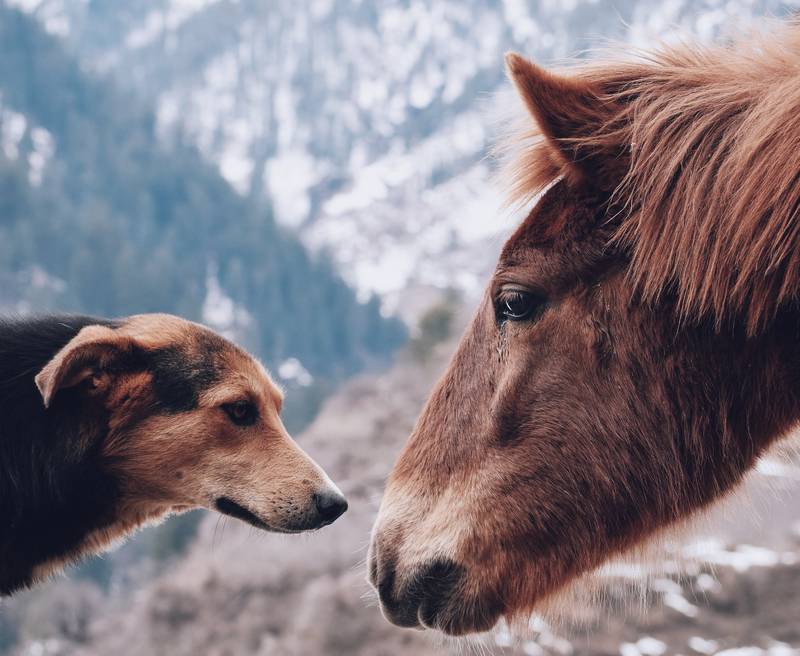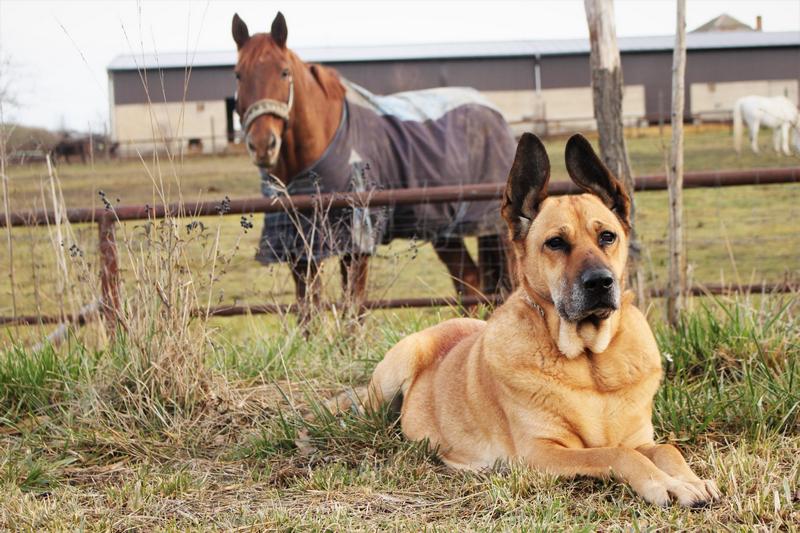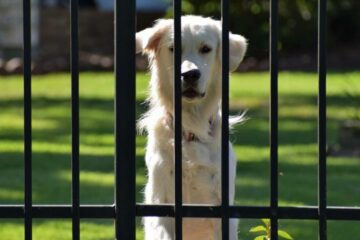Dog Barking at Horses? Learn How to Stop + Why They Do It!
Is your dog barking at horses and you can’t figure out why they do it or how to stop it? In this article, we’ll dive into why your canine companion may be reacting to horses and give you practical advice on how to curb this behavior.
We’ll shed some light on why dogs bark at horses and share effective strategies to stop your dog from barking at them. Additionally, we’ll explore what horses do when dogs bark at them and discuss what to do if it’s not just barking, but you’ve actually got a dog chasing horses.
We’ll also address how to handle your dog’s aggression towards horses, should that be the issue. Keep reading below!
Dog Barking at Horses: How to Stop

Stopping a dog from barking at horses involves consistent training, adequate socialization, positive reinforcement, and environment management. One effective strategy involves using the “Quiet” command. This command requires training and consistency to become effective.
Here’s a simple step-by-step guide on how to teach your dog the “Quiet” command:
- Command Recognition: When your dog starts barking at a horse, calmly say the word “Quiet.” Make sure to say it firmly but not loudly or in a shouting manner.
- Wait for Silence: After issuing the command, wait for a moment of silence. Dogs are smart and will soon understand that you want them to stop barking.
- Positive Reinforcement: Once your dog becomes quiet, immediately reward them with a treat or praise. This reinforces the behavior, helping them associate the “Quiet” command with being silent and receiving a reward.
- Consistent Practice: Repeat the process whenever your dog barks at horses. With consistency, your dog should start to understand what the “Quiet” command means.
Besides the “Quiet” command, other techniques such as proper socialization and environment management can also help. Gradually introduce your dog to horses in a controlled manner, starting from a distance and gradually reducing it as your dog gets comfortable.
But while these steps will get your dog to stop barking at horses, you need to remember that the underlying behavioral issues (anxiety, dominance, overexcitement, etc.) that were causing all of this to begin with will still be present. And until you address those, any positive changes you see are only going to be temporary.
“So, how do I make them stick then?”
By getting your dog to truly choose to follow your direction, that’s how. I tried many times to write out how you can do that before deciding it made more sense to just link you to the free video series that explains it better than I’d ever be able to.
The series is by a man named Dan who is one of the world’s leading dog obedience trainers. In it, he teaches you how to put an end to things like when your dog barks at horses and all other misbehavior using his fast and easy-to-follow methods.
In the first video, Dan will reveal to you why the two most common methods of dog training only doom you to failure. You can watch the video now by clicking here. Follow the proven system he’ll show you in his series and you’ll never have to spend another second worrying about your dog barking at horses ever again!
Why Does My Dog Bark at Horses?

Dogs bark at horses mainly due to their instinctual reactions towards large animals, including curiosity, fear, or the drive to chase. Understanding your dog’s behavior and adequately socializing them with larger animals can help manage such responses.
Understanding the Barking Behavior
Understanding why your dog barks at horses helps in addressing the behavior appropriately. Here are some possible reasons:
- Curiosity: Dogs are naturally curious animals, and a horse, being significantly larger and different from them, can trigger this curiosity. They may bark as an expression of interest, trying to initiate interaction.
- Fear: The large size and different movement pattern of a horse can make some dogs nervous or scared, leading to fear-induced barking.
- Chasing Instinct: Horses, like other large animals, can activate your dog’s natural chasing instinct, causing them to bark.
- Protectiveness: Dogs may also perceive horses as a threat to their owner or themselves and bark as a way to protect their territory or loved ones.
Socializing Your Dog with Horses
Getting your dog used to horses can help reduce their barking. Here are some strategies:
- Gradual Introduction: Expose your dog to horses gradually and from a distance at first. Reward them for calm behavior around horses, reinforcing positive associations.
- Training Commands: Training your dog to follow commands like “quiet” can help manage their barking behavior around horses. We explained the steps to do this in the first section.
- Professional Help: If your dog’s barking continues to be an issue, consider seeking help from a professional dog trainer or animal behaviorist.
In conclusion, dogs bark at horses due to a combination of natural instincts and unfamiliarity. A mixture of socialization and training can significantly help in managing this behavior.
It’s important to start working on things now or their behavioral issues will only get worse. If they’re not already, you’ll soon see your dog barking at the cows, barking at the sheep, attacking the goats, not getting along with the pigs, and maybe even barking at other dogs too. This will obviously get very old, so you should get to work on teaching the “quiet” command right away.
When Dogs Bark, What Do Horses Do?
When dogs bark, horses’ reactions can vary greatly depending on their individual temperament, previous experiences, and the nature of their relationship with dogs. Some may ignore it, while others may show signs of fear or agitation, such as prancing, rearing, or trying to run away.
To understand this further, let’s explore the key reasons behind these reactions:
- Natural Instincts: Horses, as prey animals, are instinctively alert and wary of noises and movements that could potentially signal danger. A dog’s bark could trigger these survival instincts, causing a horse to become scared or agitated. They might prance, rear, or even attempt to bolt as a response to a perceived threat.
- Past Experiences: A horse’s previous encounters with dogs could shape its reaction. If a horse has had negative experiences with dogs in the past — for instance, being chased or startled by a barking dog — it might react fearfully or aggressively when it hears a dog bark.
- Desensitization: On the other hand, horses that have been gradually introduced and acclimated to dogs and their behaviors, including barking, may react with indifference. They might simply carry on with their activities and ignore the barking.
- Horse’s Temperament: Each horse has a unique personality and temperament. Some are naturally more reactive or skittish than others. Horses with a calm and steady demeanor may be less bothered by a dog’s bark compared to their more reactive counterparts.
Understanding a horse’s behavior in response to a dog’s bark is essential for maintaining a safe and harmonious environment when dogs and horses are kept in close proximity. You should teach your dog the “quiet” command (which we went over in the first section) to ensure this.
Dog Chasing Horses: What Do You Do?
If you find your dog chasing horses, it’s critical to tackle this behavior right away due to the potential risks to the horse, the dog, and other people. The most effective way to address this issue is by applying a combination of command training, distraction, and gradual exposure.
Establishing Strong Command
Training your dog to respond to your commands without fail is the first step. This begins with basic commands like “sit,” “stay,” “come,” and “leave it.” Be consistent in your training and ensure that you practice in various environments, both quiet and with distractions.
Increasing the level of distraction during training can help your dog learn to follow your commands even when they’re excited or distracted. We explained more about establishing control with your dog in the first section of this article.
Using Distraction Techniques
In addition to command training, using distraction techniques can be a helpful tool in managing your dog’s behavior around horses. One common method is to use high-value treats or their favorite toy to divert their attention from the horse.
The key here is to use the distraction before they become too focused on the horse. Start the distraction as soon as you notice the initial signs of their interest in the horse, such as perking up their ears or staring.
Gradual Exposure
A systematic and careful approach to exposure can be quite effective in resolving the chasing behavior. Start by exposing your dog to horses from a distance where they don’t react and gradually decrease this distance over time.
It’s important to always keep your dog on a leash during these sessions to maintain control. Reward your dog for calm behavior during these exposure sessions. This gradual exposure helps to desensitize your dog to horses and counter-condition them to associate horses with positive experiences rather than something to chase.
Summary
Addressing your dog’s tendency to chase horses involves a holistic approach combining command training, distraction techniques, and gradual exposure. Always ensure your dog’s and the horse’s safety during this process, keeping a respectful distance and only closing this gap as your dog’s behavior improves. It’s a gradual process that requires patience, but with consistent effort, it’s possible to curb this behavior and ensure peaceful coexistence between your dog and horses.
Dog Aggression Towards Horses: How to Handle
Managing dog aggression towards horses involves understanding the root cause of the behavior, creating a safe and comfortable environment, and establishing clear boundaries for your dog. It’s crucial to remember that while dogs are typically well-suited to coexist with many different animals, horses included, sometimes their instincts or experiences can cause aggressive behaviors.
Here’s a more in-depth look at how to handle this situation:
- Understanding the Cause: Firstly, it’s essential to identify what triggers your dog’s aggressive behavior towards horses. This could be rooted in fear, past traumatic experiences with large animals, or it could be a manifestation of your dog’s protective instincts. Once you understand the specific cause, you can create a tailored plan to manage their behavior around horses. This could involve gradually desensitizing them to the presence of horses or finding ways to redirect their aggressive tendencies into more positive behaviors.
- Safe and Comfortable Environment: Secondly, ensure that both your dog and the horses have separate, secure spaces where they can retreat and feel safe. This is especially important if the aggression is fear-based, as providing your dog with a safe space can help reduce their anxiety when they encounter horses. A comfortable and stress-free environment can have a significant impact on reducing aggressive tendencies and helping your dog associate positive experiences with the presence of horses.
- Clear Boundaries: Thirdly, it’s crucial to establish and consistently enforce clear boundaries. Make sure your dog understands that they are not allowed to approach horses without your permission. This can be done by creating physical barriers, like fences or designated “dog-free” zones around the horses, and teaching your dog the boundaries within which they can move. This clear understanding of boundaries can provide a structure that can help your dog control its impulses and reduce aggression.
- Monitor Interactions: Lastly, always supervise interactions between your dog and horses, especially in the early stages of their cohabitation. By doing so, you can intervene if you notice signs of stress or aggression from either animal. Monitoring these interactions not only ensures the safety of both your dog and the horses but also allows you to understand the dynamics of their relationship better. Over time, your supervision can help you identify patterns and improve your strategies for managing your dog’s behavior.
Remember, dealing with aggression is a process and may take time. It’s important to maintain a peaceful environment for all animals involved. Learn more about maintaining a peaceful environment for your animals in the first section of this article.
I’m sure you’re looking forward to seeing these wonderful improvements in the environment around your property, so I’ll let you get started now. Good luck with everything, and thank you for reading our article “Dog Barking at Horses? Learn How to Stop + Why They Do It!”





